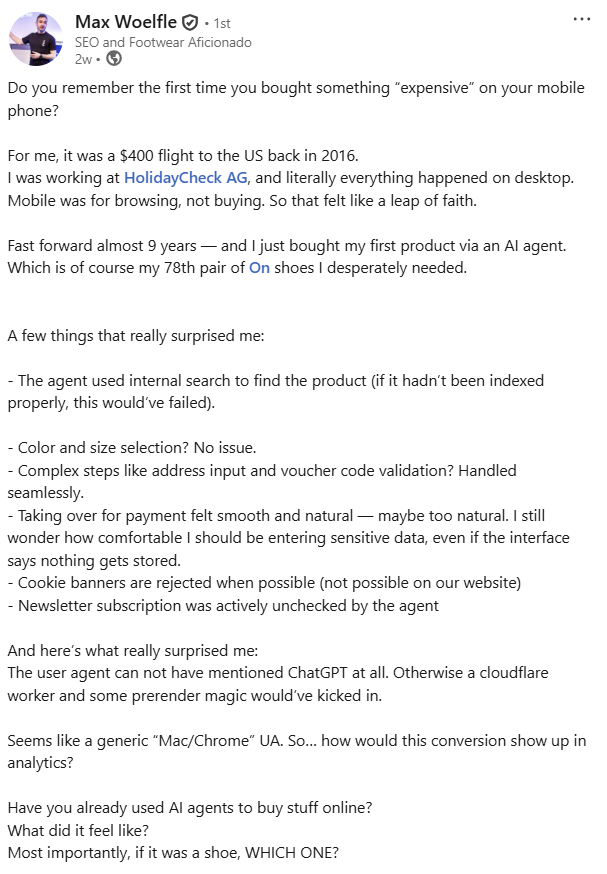Rethinking the funnel with LLM tracking analytics by Semrush Enterprise

For a decade, marketing strategy was engineered to master Google’s “messy middle.”
Today, the customer’s exploration and evaluation journey has migrated from the open web (PPC, Reddit, YouTube, websites) into closed AI environments (ChatGPT, AI Mode, Perplexity), making direct observation impossible.
Your marketing analytics stack faces funnel blindness. You must reconstruct customer journeys from fragmented data offered by LLM visibility tools.
Funnel reconstruction relies on two primary data streams
The rush to measure LLM performance has vendors promising dashboards to help you “Analyze your AI visibility right now.” This work requires reconciling two fundamentally different data streams:
- Synthetic data (the prompts you choose to track as a brand).
- Observational data (clickstream data).
Every LLM visibility tracking platform delivers products built from some extraction, recombination, or brokerage of this data.
Funnel reconstruction relies on two primary data streams
The questions, commands, and scenarios you want to track are, by their nature, synthetic.
Lab data is inherently synthetic. Lab data does not come from the real world; it is the direct output you get when you inject chosen prompts into an LLM.
Tools like Semrush’s Artificial Intelligence Optimization (also known as AIO) and Profound curate a list of prompts for brands to help map the theoretical limits of your brand’s presence in generative AI answers.
Companies use lab data to benchmark performance, spot errors or bias, and compare outputs across different queries or models. It shows how various models respond to exactly what the brand wants to test.
This approach only reflects how the system performs in test conditions, not what happens in real-world use. The data you get is pulled from a world that doesn’t exist, without any persistent user context (memories ChatGPT keeps of its users’ habits, for example). These engineered scenarios are idealized, repetitive, and distant from the messy middle and real demand.
Lab metrics show the “best case” output you get from prompts you carefully design. They tell you what is possible, not what is real. They cannot predict or reflect real-world outcomes, conversions, or market shifts.
The only actionable results come from observed field data: what actually happens when anonymous users encounter your brand in uncontrolled environments.
Synthetic persona injection and system saturation

Some vendors use two bold strategies – system-level saturation and user-level simulation – to compensate for the lack of real customer data.
“Sometimes, personas are assigned to these prompts. Sometimes, it boils down to brute-forcing a thousand prompt variants to see how LLMs respond,” said Jamie Indigo, Technical SEO authority.
One strategy, employed by vendors like Brandlight, is system-level saturation. This brute-force approach maps a brand’s entire citation ecosystem by analyzing millions of AI responses.
System-level saturation is designed to maximize exposure by revealing the structural footprint of the system itself, rather than modeling user behavior. This approach is designed to maximize influence and exposure in AI environments by targeting the most impactful sources, rather than a tool for modeling or predicting authentic user behavior.
The alternative strategy is user-level simulation, used by tools like Quilt. This involves injecting thousands of synthetic personas into the testing environment. Persona injection means creating simulated users for your prompts (distinct types, priorities, edge-case scenarios) and feeding their tailored prompts to an LLM in testing environments.
Experts like Indigo acknowledge the value of this approach, which helps expose clarity gaps and reveal edge behaviors. Others, like Chris Green, a veteran Fortune 500 SEO strategist, underscore its arbitrary nature, pointing out that it remains disconnected from real-world behavior patterns.
These synthetic personas may offer structural insight and help brands stress-test, but do not predict audience outcome or campaign ROI.
These methods are useful for product teams that need fast, cheap feedback on their logic, language, and interactions. They cannot reproduce the randomness and unpredictability of actual users.
Real user behavior, as captured in clickstream data, rarely matches lab personas or occurs in any meaningful sequence. Case in point: humans are now starting to rely on agentic AI to make online purchases.

Clickstream data: Validating what’s real

If lab data maps the possibilities, field data validates reality.
That data is clickstream data, the record of how users interact with digital platforms:
- Pages they view.
- Results they click.
- Paths they follow.
Companies like Similarweb or Datos (a Semrush company) offer data capturing genuine user actions, collected through browser extensions, consented panels, app telemetry, and provider networks.
Visibility tools like Semrush’s AIO and Profound are built on this principle, leveraging clickstream data, sequential metrics showing which AI results are seen, engaged with or ignored.
This is the only ground truth available, exposing your brand’s real-world impact and pinpointing the precise moments of friction or success.
The integrity of the underlying clickstream data of any LLM visibility tool is central to validating what’s real.
Most analytics platforms buy data from brokers, so the quality of your insights is dictated by the quality of their source.
You should focus on scale and quality when it comes to clickstream data. Ask the following questions of any platform/tool you are considering:
- What is the scale? Aim for tens of millions of anonymized users across relevant device/region.
- Is the data cleaned, deduplicated, and validated?
- What about bot exclusion and compliance?
No dashboard or reporting tool can be trusted if it is not built on strong clickstream signals. Weak clickstream panels, small samples, limited geographies, hide minority behaviors and emergent trends.
Most AI analytics do not own their clickstream panels (except Semrush’s AIO); they buy from brokers who extract from global browser/app data. Vendors segment only as far as their panels stretch.
Datos sets the current standard for reliable, real-time, actionable clickstream data. As the largest global panel operator, it provides the backbone for visibility platforms, including Semrush AIO, and Profound.
Tens of millions of anonymized users are tracked across 185 countries and every relevant device class. This data ensures you are anchoring market decisions in a way that synthetic personas or millions of curated brand prompts cannot.
Where strategy is forged
Lab data, including all the prompts you curate and track, is only half the story. Without the validation of field data (clickstream data), your lab data remains an idealized marketing funnel.
Field data, without the context of the lab’s map, is just a rearview mirror, providing the “what” but never the “why.”
Manage the delta between the two, reconcile, and calibrate the map of what’s possible in an ideal scenario against evidence of what actually works and brings revenue. This is the feedback loop you should seek from LLM visibility tools. The actionable intelligence, the actual strategy, is forged in the gap between them.
You should consider the “messy middle” a dynamic intelligence feedback loop, not a static funnel analysis.
Modern online marketing means mapping what is possible with what is profitable.






Recent Comments